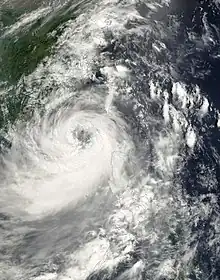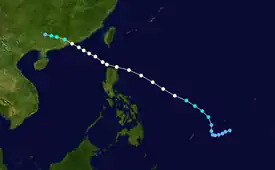 Tropical Storm Utor shortly after peak intensity on July 5 | |
| Meteorological history | |
|---|---|
| Formed | July 1, 2001 |
| Dissipated | July 7, 2001 |
| Severe tropical storm | |
| 10-minute sustained (JMA) | |
| Highest winds | 110 km/h (70 mph) |
| Lowest pressure | 960 hPa (mbar); 28.35 inHg |
| Category 1-equivalent typhoon | |
| 1-minute sustained (SSHWS/JTWC) | |
| Highest winds | 150 km/h (90 mph) |
| Lowest pressure | 963 hPa (mbar); 28.44 inHg |
| Overall effects | |
| Fatalities | 203 total |
| Damage | $2.78 billion (2001 USD) |
| Areas affected | Philippines, China and Taiwan |
| IBTrACS | |
Part of the 2001 Pacific typhoon season | |
Severe Tropical Storm Utor, known in the Philippines as Typhoon Feria, was a large and deadly system that caused heavy rains and landslides throughout the Philippines, Taiwan, and China.[1][2] The eighth tropical depression and fourth named storm of the 2001 Pacific typhoon season, Utor formed on July 1 and intensified into a tropical storm shortly after. Utor was upgraded to a typhoon by the JTWC on July 3, and a day later, Utor was estimated to have peaked with 10-min winds of 110 km/h (70 mph), with the JTWC estimating 1-min winds of 150 km/h (95 mph). After passing just north of Luzon, Utor began to weaken, before making landfall on the district of Dapeng as a minimal typhoon. Utor caused 203 deaths, of which 168 were in the Philippines, 23 were in the province of Guangdong, 10 were in the province of Guangxi, and 2 were in Taiwan. Total damages from the storm amounted to $2.78 billion.
Meteorological history

Tropical storm (39–73 mph, 63–118 km/h)
Category 1 (74–95 mph, 119–153 km/h)
Category 2 (96–110 mph, 154–177 km/h)
Category 3 (111–129 mph, 178–208 km/h)
Category 4 (130–156 mph, 209–251 km/h)
Category 5 (≥157 mph, ≥252 km/h)
Unknown
At 21:30 UTC on June 26, the Joint Typhoon Warning Center (JTWC) began monitoring a system in the Western Pacific Ocean. On June 29 at 12:30 UTC, the JTWC issued a Tropical Cyclone Formation Alert (TCFA) on the system.[2] The system continued moving to the southwest and on July 1 at 0:00 UTC both the Japan Meteorological Agency (JMA) and the JTWC upgraded the system to a tropical storm, with the JMA giving it the name Utor.[3] Shortly after being named, Utor abruptly turned to the north, passing just west of the island of Yap. On the next day at 6:00 UTC, Utor entered the Philippine Area of Responsibility and was named Feria by the Philippine Atmospheric, Geophysical and Astronomical Services Administration (PAGASA), which also began issuing advisories.[4] Utor steered northwestward as it was gradually strengthening, being upgraded to a typhoon by the JTWC east of Luzon on July 3.[3] The JMA followed suit, upgrading it to a severe tropical storm.[5] Utor continued to strengthen as it continued northwestward, and on July 4, Utor made its closest approach to the island of Luzon, peaking in the process with 10-min winds of 110 km/h (70 mph), with the JTWC estimating 1-min winds of 150 km/h (95 mph).[5][2] Utor developed a ragged eye during peak intensity, with the island of Calayan being in the eye.[2][3] After peak intensity, Utor slowed down slightly, beginning to weaken as it approached the Chinese province of Guangdong. On July 6 at 0:00 UTC, Utor made landfall on the district of Dapeng as a minimal typhoon, quickly weakening over land. 18 hours later, the JTWC issued its final warning on the system, and the JMA followed suit not long after.[2] Utor dissipated over the autonomous region of Guangxi.[1]
Impacts
Philippines
Utor, while not a very strong storm, brought heavy rain causing many landslides and flooding throughout the countries it affected. Almost 1 million people spread out over 20 provinces in the Philippines were affected by the typhoon, with thousands of houses being destroyed or damaged.[2] Effects and impacts from Utor in the Philippines amounted to greater than $37 million (2001 USD) in damage, as well as causing at least 168 fatalities.[6][3] At least 17 landslides occurred throughout the Philippines.[3] In Baguio, rainfall from Utor set a new 24-hour rain record.[3] Due to the effects of the storm, on August 13, President Gloria Macapagal Arroyo declared a state of calamity in the Ilocos Region and in the Cordillera Administrative Region.[7]
Hong Kong and China
During Utor's passage, a 980 hPa reading was recorded in Hong Kong.[3] 87 flights were canceled and 402 more were delayed due to the storm on July 6 in Hong Kong, with crops, roads, power lines, and other infrastructure in Guangdong being heavily damaged.[8][9] A total of 23 people were killed and damages in Guandong amounted to ¥6.7 billion (US$813 million) (2001 USD).[1][3] In Guangxi, economic losses were estimated at ¥16 billion (US$1.93 billion) (2001 USD), with 10 people being killed and another 6,850 people injured.[3] In Nanning, the Yong River rose to 5.4 meters above its danger level, the highest it has reached in 50 years.[3]
Taiwan
Agricultural losses in Taiwan amounted to NT$68 million (US$2 thousand) (2001 USD). 2 people were killed and 6 were injured due to torrential rains and strong winds.[1]
See also
References
- 1 2 3 4 "HKO Tropical Cyclones in 2001" (PDF). April 2002. Archived from the original (PDF) on November 4, 2019. Retrieved March 5, 2021.
- 1 2 3 4 5 6 2001 Annual Tropical Cyclone Report (PDF) (Report). Retrieved February 16, 2021.
- 1 2 3 4 5 6 7 8 9 10 "Monthly Global Tropical Cyclone Summary July 2001". australiasevereweather.com. Retrieved February 16, 2021.
- ↑ "Typhoon2000.com's STORM LOG on TY UTOR/FERIA/0104 (July 01 - 06, 2001)". typhoon2000.ph. Retrieved March 7, 2021.
- 1 2 "JMA Best Track Data" (PDF). Retrieved February 16, 2021.
- ↑ "Philippines - Typhoon Utor OCHA Situation Report No. 2". ReliefWeb. Retrieved February 6, 2021.
- ↑ "Proclamation No. 81, s. 2001". August 13, 2001. Retrieved March 4, 2021.
- ↑ "CNN.com - China, Philippines count cost of Utor's blast - July 8, 2001". edition.cnn.com. Retrieved February 16, 2021.
- ↑ "Typhoon Utor Kills More Than 100". www.cbsnews.com. Retrieved February 16, 2021.
